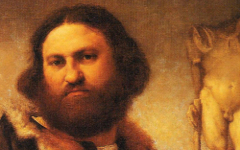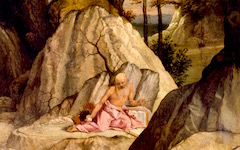Lotto’s Judith with the Head of Holfernes (1512)

Lotto, Judith and Her Maidservant with the Head of Holofernes (1512) Banca Nazionale del Lavoro, Rome
Click image to enlarge.
Swords in poetic art paint which is why, given that every painter paints himself, so many decapitated heads in art feature a self-portrait or, at the very least, an alter ego. Blood, too, in such a context is paint. In slicing the neck the executioner (a woman in this case) creates a capolavoro, literally head-work, the Italian word for a masterpiece. Holofernes' head is "a painting". Then, with Judith as the painter in his imagination, the male artist expresses the androgyny of his creative mind as well.
Click next thumbnail to continue

Top: Detail of El Greco's Knight Taking an Oath (1578-80)
Bottom: Detail of Picasso's Bullfight Scene (1955)
Click image to enlarge.
Swords in art symbolize not only paintbrushes but other more traditional meanings including the power of rational thought to impose a solution on chaos like St. George when he tames the dragon. Elsewhere we have seen how the sword in El Greco's Knight (top) spells D for Domenico, El Greco's real name. It too is inverted as a reflection in the mirror of the artist's mind. The sword in Picasso's painting (bottom) also spells P for Pablo Picasso.
Click next thumbnail to continue
Thus in the hilt of Judith's sword we see an L for Lorenzo Lotto in the (left) corner where signatures are often placed. Inverted, though, for the same reason as El Greco's initial, it is really in the right corner, the more common space for a signature. Artists with the same initial twice seem to make extra use of this little-known method of identification. Lorenzo Lotto used the shape on a number of occasions, L-shaped forms which appear so naturally as part of the scene that specialists have never recognized them.
Click next thumbnail to continue
Notably, given the difference in their social standing, Judith and her maid share many features: their body type, hanging earrings, the blondness of their hair parted in the middle, similar eyes and eyebrows. Their chins and mouths are similar too. They differ, however, in the bold primary colors of their clothes and their contrasting noses. Where Judith's hook descends towards the mouth, the maid's porcine variety rises upwards, suggesting the unity of opposites and thus the wholeness of Lotto's mind. Both represent Lotto, two states of mind, one noble and rational in cool blue (Judith), the other an animal-like consciousness in hot colors (yellow orange) linked to nature.
Click next thumbnail to continue
With one L in the lower left corner close to the edge, there might be another on the maidservant near the right edge (see diagram). It would make sense. Given that the sword of the first L conveys phallic (male) power, the second L's proximity to the maid's breast, itself shaped like a breast with a prominent nipple, conveys creative fertility (feminine) so that the two together convey androgyny.
See conclusion below
This analysis has been written without any real reference to the biblical story. This is in part to show you what you can achieve by yourself without in-depth knowledge of scriptural sources and, in part, to demonstrate that the spiritual violence associated with creative birth while clearly spiritual in nature is non-religious.
More Works by Lotto
Find out how a realistic portrait is something else entirely

Lotto’s Portrait of Andrea Odoni (1527)
Notes:
Original Publication Date on EPPH: 25 Nov 2012. | Updated: 0. © Simon Abrahams. Articles on this site are the copyright of Simon Abrahams. To use copyrighted material in print or other media for purposes beyond 'fair use', you must obtain permission from the copyright owner. Websites may link to this page without permission (please do) but may not reproduce the material on their own site without crediting Simon Abrahams and EPPH.





